Today at the Microsoft Ignite conference in Orlando, Florida, we announced new Microsoft 365 innovations in six key investment areas: productivity, knowledge, workflow, security, compliance, and management. Microsoft 365 is the world’s productivity cloud, and the consistent theme across these new features is how we’re using artificial intelligence (AI) to deliver amazing new experiences that push the boundaries of productivity. From new Microsoft Teams enhancements to the first new service we’ve launched since Teams, we have a lot to share with you—so let’s get to the news.
Productivity
Microsoft 365’s productivity tools use AI to help people create, collaborate, analyze, write, present, organize, and manage their work. Our innovations in core productivity are focused on two opportunities: creating entirely new experiences that take advantage of the latest innovations and breathing new life into familiar apps and experiences with powerful cloud services.
Microsoft Teams
Microsoft Teams is the hub for teamwork. In response to requests from Teams customers, we’re pleased to announce Private channels, Multiwindow chats, meetings and calls, pinned channels, and task integration with To Do and Planner. We’re improving collaboration capabilities between Outlook and Teams, making it easy to send an email thread to a Teams channel for further discussion.
And we’re bringing the Yammer app into Teams, adding the ability for users to pin the app to the left-hand rail and making Teams the hub for both focused team collaboration and broad, open communities. We are also delivering new industry-tailored innovations and experiences including tools for Healthcare and Firstline workers. Healthcare providers can now schedule and conduct B2C virtual consultations through Teams with new Virtual Consults capabilities, and new features like SMS Sign-In and Global Sign-Out make it quick and easy for Firstline workers to securely access Teams from their mobile devices.

The New Microsoft Edge
Microsoft Edge and Microsoft Bing are the web browser and search engine for business. We are pleased to announce that the general availability of the all-new Chromium-based Microsoft Edge browser is targeted for January 15, 2020. You can download the release candidate today.
The all-new Microsoft Edge offers the enterprise new tab page, where you’ll have direct access to your Microsoft 365 files, sites, and intranet search, making every tab you open a portal to productivity. And with the new Microsoft Search in Bing integration, searching for information at work is as easy as searching the web. You can now access files, people, office floorplans, acronym definitions, and more company information from across your Microsoft 365 ecosystem right from the search bar.
Finally, Microsoft Edge is now available across all your devices—including Windows 10, Windows 8x, Windows 7, macOS, iOS, and Android. Your passwords and favorites will roam seamlessly across all your devices—and with native Azure Active Directory (Azure AD) sign-in, you can search for work files right from your phone.
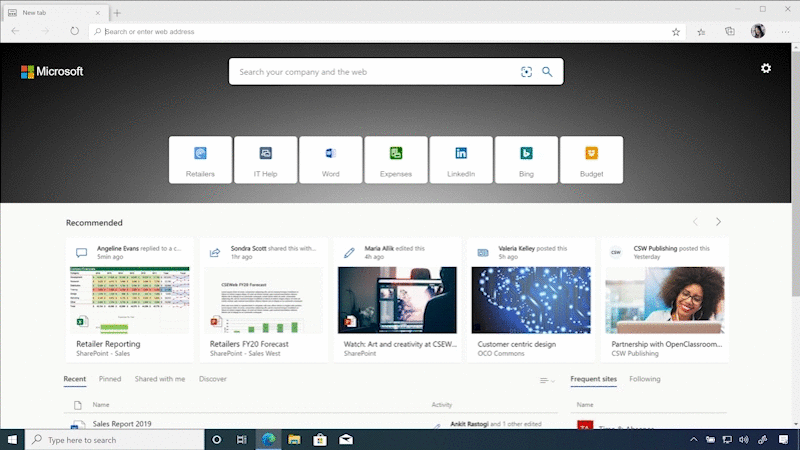
The Office mobile app
We all want to be able to work on the go from mobile devices and we’re always looking to simplify and improve the experience. Today, we’re announcing a new mobile experience for Office that combines three of the suite’s most popular apps—Word, Excel, and PowerPoint—into a single go-to app for mobile productivity. Now you no longer need to download each app separately and will have everything you need to be productive on the go. And with the new Actions pane, you can intuitively complete a variety of common on-the-go tasks, such as creating and signing PDFs and sharing files between devices.
The new Office app uses the unique advantages of mobile devices to make content creation easier. You can snap a picture of a document and turn it into an editable word file, for instance, or transform tables from a printed page into an Excel spreadsheet. Launched today as a public preview, the Office app is available to Android users through the Google Play Store and to iOS users through Apple’s TestFlight program.
Fluid Framework
At Build 2019, we announced Fluid Framework, a new technology and set of experiences that will make collaboration seamless by breaking down the barriers between apps. It offers three key capabilities. First, experiences powered by the Fluid Framework will support multi-person coauthoring on web and document content at industry-leading speed and scale. Second, it provides a componentized document model that allows authors to deconstruct content into collaborative building blocks, use them across applications, and combine them in a new, more flexible kind of document. Third, the Fluid Framework makes room for intelligent agents to work alongside humans to translate text, fetch content, suggest edits, perform compliance checks, and more.
Today, we are announcing a public preview of the Fluid Framework end user experience and a private preview for developers. Over time, we expect these capabilities to light up in experiences across Microsoft 365, including within chat in Teams, mail in Outlook, portals in SharePoint, notes in OneNote, and documents in Office.
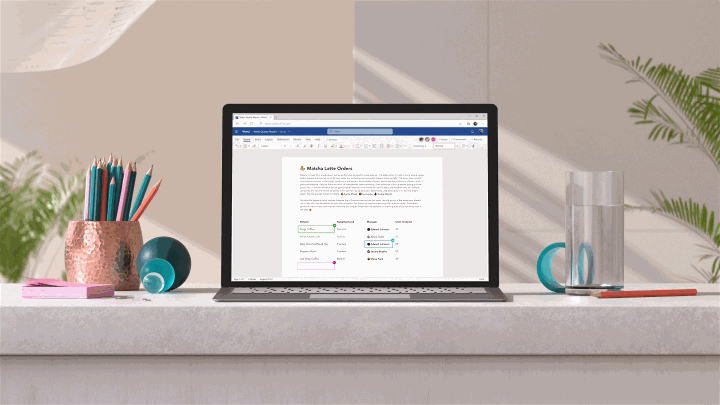
Cortana
We’re using AI to bring you personalized experiences in Outlook and making Cortana your personal productivity assistant. Today, we announced Play My Emails in Outlook for iOS to help you catch up and act on emails hands-free. With new natural voice and language recognition, Cortana can intelligently read out your new emails and share changes to your day. A masculine voice option is also now available with Play My Emails, further customizing your personal productivity assistant experience. We’re also announcing that Scheduler in Outlook is shipping in preview; you can use it to hand off scheduling meetings and coordinating participants to Cortana.
Beginning next month, Cortana can also help you prepare for your day by sending you a briefing email that includes a summary of your meetings, relevant documents for your day, and reminders to follow up on commitments you’ve made in email.
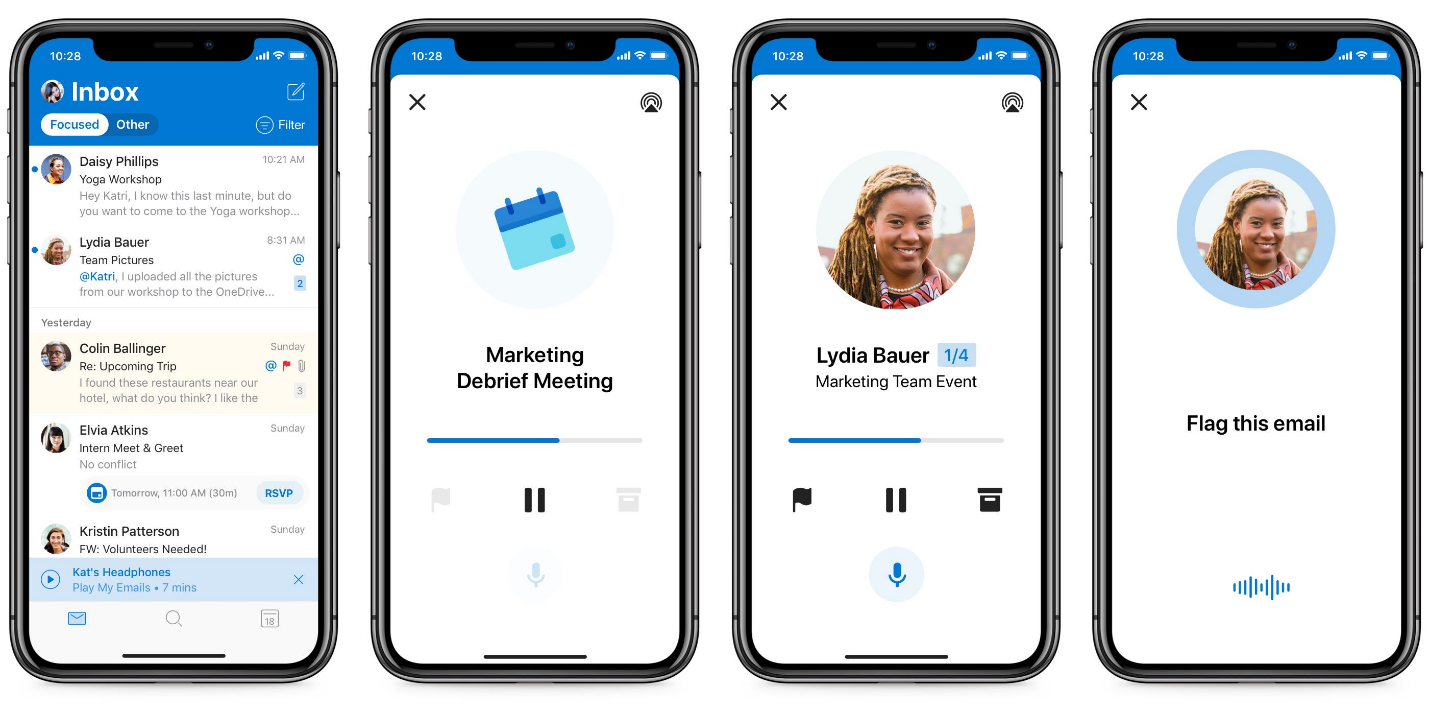
AI in Office
You’re busy and have a lot on your mind—and even more on your to-do list. We get it, and over the past year, we brought the magic of AI to Office to help you get more done. With innovations that include entering data into Excel with a digital pen, audio transcription in Word—which converts a new or existing audio file into a written transcription—and Presenter Coach in PowerPoint (in public preview for the web), which helps business professionals, teachers, and students become more effective presenters, we committed to enlightening Office with AI to help you be more productive.
Today our journey continues. Now Excel supports natural language queries, so users can now ask a question of their data, just like they would if they were talking to a person, and get quick answers—all without having to write a formula. Available to Office Insiders, this new natural language ability is another step towards making data insights and visualization more approachable and accessible to users with various levels of Excel experience.
We’re also making it easier for you to plan time away from work and continue to improve your work best practices. For example, MyAnalytics can help you prepare for time off by automating out of office notification setup, informing collaborators of your time away, resolving meetings you’ll miss, and more. Integrated into the Insights pane in Outlook, MyAnalytics is now able to encourage best practices like booking meetings promptly, adding an agenda, and meeting follow ups, and adding new AI-powered suggestions in Outlook that allow you to delay email delivery when working outside the recipient’s working hours.

Microsoft Project
Last week, we announced a major step toward achieving our new vision for project management with the general availability of the new Microsoft Project. The new Project offers a redesigned user experience that is simple and intuitive. Teams can quickly add new members and set up tasks, and then easily switch between grids, boards, or timeline (Gantt) charts to track progress. And because Project is part of the Microsoft 365 family, project teams can save time and do more with built-in connections to familiar apps like Teams and Office. In addition, the new service provides greater visibility into your projects and powerful tools to help you anticipate future needs. Create stunning interactive reports in Power BI, so you can visualize every aspect of each project at a glance. And get the big picture view of all your projects across your organization with visual, interactive cards.
Over the next year, we’ll release more exciting capabilities in the new Project, including resource management, budget analysis, and time and expense tracking. These powerful features will enable you to streamline more complex initiatives and help your business maximize ROI.
Knowledge
We’re excited to announce a brand-new investment area for Microsoft 365—knowledge. Moving your productivity infrastructure to the cloud has many benefits, including cost savings and streamlined operations. But it also unlocks new scenarios. Using AI, Microsoft 365 will now be able to identify, organize, and deliver knowledge across your organization—providing just the right information at just the right time. Productivity isn’t just about being more efficient. It’s also about aggregating and applying the collective knowledge of your organization so that together you can achieve more.
Project Cortex
Today, we’re announcing Project Cortex, the first new service in Microsoft 365 since the launch of Teams. Project Cortex uses AI to create a knowledge network that reasons over your organization’s data and automatically organizes it into shared topics like projects and customers. It also delivers relevant knowledge to people across your organization through topic cards and topic pages in the apps they use every day.
In addition, Project Cortex enables business process efficiency by turning your content into an interactive knowledge repository—with innovations in smart content ingestion—to analyze documents and extract metadata to create sophisticated content models; machine teaching, to allow subject matter experts to teach the system how to understand semi-structured content; and knowledge retrieval, to make it easy for people to access the valuable knowledge that’s so often locked away in documents, conversations, meetings, and videos. Building on the content you already have in SharePoint, Project Cortex connects content across Microsoft 365 and external systems and enables you to manage information and streamline processes with built-in security, compliance, and workflow.
The new Yammer
Yammer has been completely redesigned, with dozens of new capabilities that empower people to connect, build communities, and share knowledge across the organization. The new Yammer delivers a beautiful, intelligent experience across devices and introduces new integrations with Teams, SharePoint, and Outlook. You can now use Yammer to broadcast live and on-demand events with a streamlined production option that uses webcams and desktop sharing. And you can also share video shorts directly from the Yammer mobile app. In addition, we’ve now centralized e-Discovery, data governance, and Yammer administration in the Microsoft 365 admin center.
Microsoft Search
Today, we announced new innovations for Microsoft Search to enhance productivity; empower greater discovery of information, insights, and people; develop search driven applications; and extend the benefits of Microsoft Search to content outside of Microsoft 365. We recognize search works best when it brings together information from across your organization. Now with over 100 new Microsoft Search connectors from Microsoft and our partners, you can consolidate information from disparate system into a single search experience in Microsoft 365.
In addition, you can use our new Graph APIs to develop custom applications on top of Microsoft Search to tailor search to your organizations’ needs. We’re also bringing more powerful search experiences to Microsoft 365, including advanced people search using attributes and skills, video search, acronym search, and semantic search.

Microsoft Stream
Video is an increasingly powerful medium for capturing and sharing knowledge and learning. Microsoft Stream applies AI to unlock the content in video—including meeting recordings—with automatic transcription. AI also powers the new voice enhance feature, allowing you to focus on the spoken word by reducing background noise. And now people can create short videos from mobile devices and share in Yammer, Teams, and PowerApps, mainstreaming video as the new content type for communications and learning.
Workplace Analytics
Workplace Analytics is making it even easier to gain knowledge about the way people work and its impact on business and organizational outcomes. Business leaders will get at-a-glance insights to quickly understand and improve meeting culture, manager practices, organizational networks, and customer relationships. Industry benchmarks help contextualize common patterns that influence productivity, such as focus time and the ability to unplug outside of working hours. We also enriched the analyst toolset. AI-driven process analysis uses key words like “quarterly business review” to shed light on time and resources invested in specific business activities, enabling improvement over time.
Workflow
Workflow innovations empower you to streamline and improve business processes with little or no code. This approach not only saves time and money, it also ensures process automation is done by the people who are closest to the way things actually work.
Power Platform integration with Teams
With Power Platform, users can automate routine tasks, create custom apps, and easily engage with data. Power Platform integration with Teams makes these tools more discoverable and accessible to users and unlocks a conversational approach to streamlining productivity scenarios—from managing approvals directly in chat to pinning a custom app where a team needs it.
Today, we announced new features to enhance these capabilities. Power Apps creators can now publish their apps as Teams apps, and users will be able to pin those apps to their left rail in Teams. We’re also adding new Power Automate triggers and actions, allowing users to streamline the completion of common team and personal tasks, such as setting custom message actions and sending notifications. And coming soon, rich Power BI previews in Teams chat and an enhanced Power BI tab will allow users to see all their data in Teams and effortlessly discuss data, to speed data-driven decision making.
Office Scripts
Office Scripts simplifies clunky processes and automates repetitive tasks so you can work less while doing more. Today, we introduced scripting in Excel, a new process automation feature that allows you to record your actions inside a workbook and save it to a script. The saved script can then be integrated with Power Automate and scheduled to run automatically or integrate with a larger flow. Office Scripts will be available as a public preview by the end of the year.
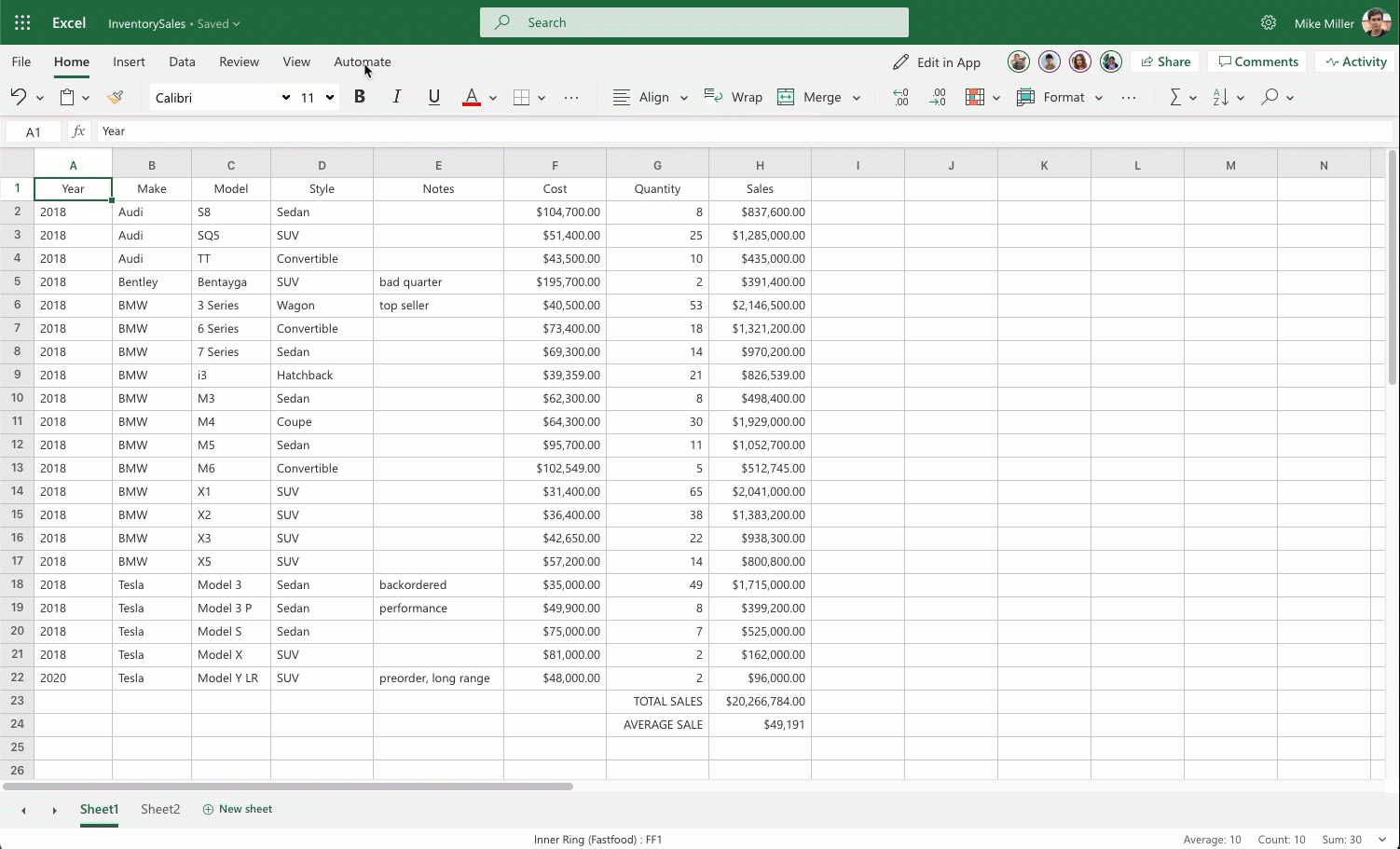
Security
New AI-powered features make it easy for you to secure your organization’s valuable assets while empowering employees to collaborate freely.
Microsoft Authenticator
Any customer with any Azure AD plan, including a free plan, can now use the Microsoft Authenticator app for secure, passwordless access to both Microsoft and non-Microsoft apps. Passwords continue to be the weakest link in cybersecurity. With Azure AD and Microsoft Authenticator, enterprises can go passwordless for a great user experience and lower support costs while also implementing two-factor or multi-factor authentication (MFA) for greater security. Deploying MFA reduces the risk of phishing and other identity-based attacks by 99.9 percent and is the best thing you can do to improve your security. Customers with more than 150 seats can also now contact Microsoft to set up the capability via FastTrack.
New value in Azure AD
Azure AD Cloud Provisioning now makes it easier to move identities to the cloud by eliminating the need for an on-premises sync server though a lightweight on-premises agent. This enables provisioning from multiple, disconnected on-premises Active Directory (AD) forests and harnesses the power of the cloud to tackle common directory challenges like sync complexity and data transformation logic. This capability addresses one of the top needs for large enterprise customers that manage complex organizations or mergers and acquisitions and enables greater availability and decreases implementation and operation costs.
Microsoft Defender Advanced Threat Protection (ATP)
Microsoft Defender ATP endpoint detection and response (EDR) capabilities are now available in preview for Mac OS devices. We’ll be adding support for Linux servers next. This is part of our commitment to extending multi-platform coverage in our threat protection solutions. Our customers depend on Microsoft for world-class endpoint protection and EDR capabilities for Windows, and most large organizations manage a complex mix of technology platforms, including several operating systems. They need coverage for the full breadth of their environment. This ongoing investment gives them the breadth of coverage they need, with a single unified view for administrators and security operations professionals, enabling enterprise-wide investigation and response to security incidents.
Application Guard for Office
Now available in private preview, Application Guard for Office provides hardware-level and container-based protection against potentially malicious Word, Excel, and PowerPoint files. It utilizes Microsoft Defender ATP to establish whether a document is either malicious or trusted.
Compliance
Simplify and automate risk management with new innovations that use AI as a force multiplier to keep you one step ahead of the increasingly complex compliance requirements and ever-evolving insider threats.
Insider Risk Management
A staggering 53 percent of organizations have experienced an insider attack in the last 12 months. The effort required to identify these risks and violations is not trivial, and it requires effective collaboration across security, human resources (HR), and legal—as well as a balanced approach across privacy and risk management. Today, we announced Insider Risk Management in Microsoft 365 to help organizations quickly identify and remediate insider threats, risks, and code of conduct policy violations across Office, Windows, Azure and third-party apps such as HR systems. Insider Risk Management leverages the Microsoft Graph and other services to intelligently correlate multiple signals to identify hidden patterns and potential risks, and provide real-time insight into file activity, communications sentiment, and abnormal user behaviors. Insider Risk Management includes a set of configurable playbooks tailored specifically for risks—such as digital IP theft and confidentiality breach—to help you effectively identify threats and take action. We also designed for privacy, so display names for risky users can be anonymized by default at early stages of investigation.
Compliance Score
It’s more important than ever to have the knowledge and tools you need to work across compliance and risk management teams to effectively assess and monitor risks. To help you implement more effective data protection controls, we’re announcing the public preview of Microsoft Compliance Score, which enables you to simplify and automate risk assessments. With Microsoft Compliance Score, you can now continuously assess and monitor data protection controls, get clear guidance on how to improve the score, and leverage the built-in control mapping to scale your compliance efforts across regulations and standards.
Even if you’re not an expert in complex regulations like General Data Protection Regulation (GDPR) or ISO 27001, you can still quickly learn the actions needed for compliance and contribute towards progress. We also introduced new assessments for California Consumer Privacy Act (CCPA), and for other GDPR-style regulations. Compliance Score is available now in public preview for all Microsoft 365 enterprise plans in the Microsoft 365 compliance center.
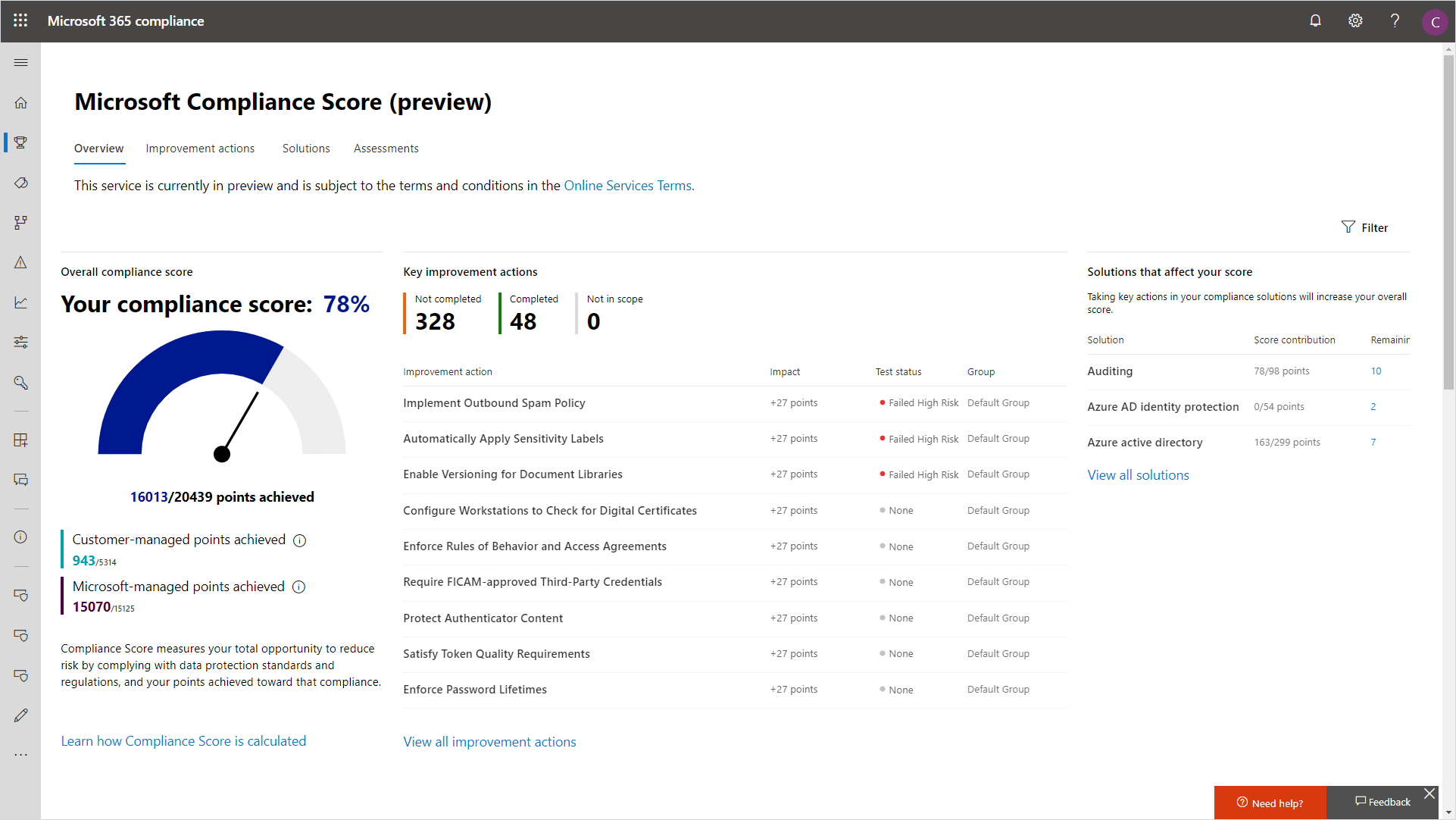
Management
With new management innovations, Microsoft 365 puts the cloud and AI to work to help you set-up, secure, monitor, and manage all your devices.
Microsoft Endpoint Manager
Microsoft Endpoint Manager is an integrated solution to centrally and securely manage all the endpoints in your technology estate. Bringing together Microsoft Intune and System Center Configuration Manager functionality and data—plus new intelligent actions and analytics—Endpoint Manager delivers seamless, end-to-end management for Windows, Android and Apple devices, apps, and policies without the complexity of a migration or disruption to productivity. Look for Microsoft Endpoint Manager features and experiences to appear in the product over the coming months. And, to help ensure that all our customers are able to take advantage of Microsoft Endpoint Manager, we’re making Intune available to our existing SCCM customers for Windows PC management. Starting December 1, 2019, you can co-manage these devices in Microsoft Endpoint Manager, and start using cloud-powered features like Autopilot and Desktop Analytics.
Microsoft Productivity Score
Microsoft Productivity Score focuses on two areas: the Employee experience and the Technology experience. Both provide visibility into how your organization works, insights to identify where you can enable improved experiences, and actions you can take to update skills and systems—so everyone can do their best work.
The Employee experience shows you how Microsoft 365 is helping to create a productive and engaged workforce. By quantifying how people are collaborating on content, working from anywhere, developing a meeting culture, and communicating with each other, you can see the different ways that work gets done. Meanwhile, the Technology experience provides insights by assessing policies, device settings, and hardware and application performance within the organizational environment and recommends actions in Microsoft Endpoint Manager.
Managed Meeting Rooms
Productive meetings are essential to success in the modern workplace. Coupled with the rise in remote collaboration, business leaders increasingly associate more effective meetings with having the right meeting room technology and environment. Today, we’re announcing a private preview of Managed Meeting Rooms from Microsoft, a new offer for managing meeting rooms. This cloud-based IT management and security monitoring service ensures that Teams meeting rooms are secured, up to date, and proactively monitored for a great in-room experience. To date, we’ve been working with more than 100 customers to manage more than 1,500 meeting rooms. Now, a private preview is opening this experience to more of you! If you’re interested in participating, let us know.
Global reader
You told us you want to improve your security posture by scoping admin permissions to only those needed to do their jobs. In fact, this is one of our top customer requests. We’re announcing new admin roles in Azure AD and the Microsoft 365 admin center to help you reduce the number of Global admins in your organization. For example, the Global reader role lets an admin view information across Microsoft 365, but does not allow the admin to change any settings or data. Now you can assign the Global reader role to admins in your organization to support reporting, planning, audits, and investigations, without having to grant a higher level of privileges than is necessary. The Global reader role can also be combined with other administrative roles (for example, Exchange admin) to more granularly control and scope the assignment of admin privileges in your organization.
Onboarding Hub
You also told us that you want guidance from Microsoft for improving security and increasing admin efficiency. The Onboarding Hub, in the Microsoft 365 admin center’s setup area, includes new experiences to help you discover, learn about, and use features across Microsoft 365, including Azure AD and other admin portals such as the Security and Compliance Center. We provide intelligent recommendations—based on your current configuration and admin activities—to help you improve your security posture, maintain compliance with data regulations, keep apps up to date, and reduce costs.
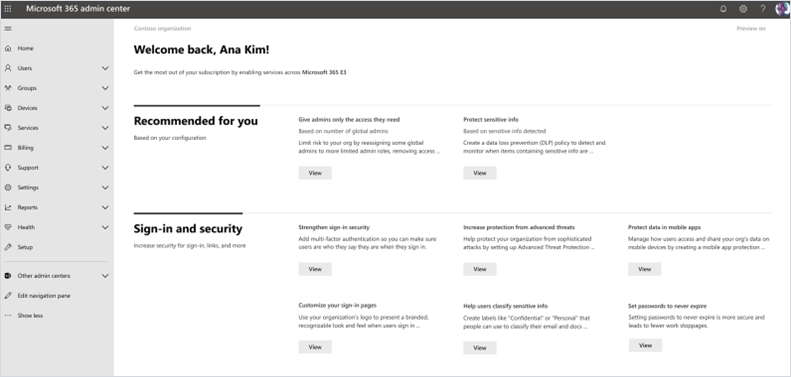
New recommendations in the Microsoft 365 admin center (admin.microsoft.com).
Using the Global reader role to access the Onboarding Hub is a powerful and safe way to perform planning and auditing activities for Microsoft 365, as a Global reader can view and assess the recommendations, learn about implementation steps and user impact, and see current administrative assignments without making any tenant or configuration changes.
Office 365 Groups
Office 365 Groups is the membership service that powers collaboration and drives teamwork across Microsoft 365. It’s a core underpinning of more than 20 applications, including Teams, SharePoint, Outlook, Yammer, Microsoft Stream, and more. We’re pleased to announce a number of improvements to the Groups admin experience with new lifecycle management and compliance capabilities, including the ability to quickly create teams for a group, browse and restore deleted groups, edit the group email alias, and use sensitivity labels. You can also enable self-service group creation and management, which empowers users to create teams and Yammer channels that are controlled with guardrails and policies set by IT.
Send us your feedback
Every innovation we make with Microsoft 365, the world’s productivity cloud, is designed to help you and your organization unlock new forms of productivity to achieve more. We’re excited to share these new features with you, and look forward to your feedback and insights.



